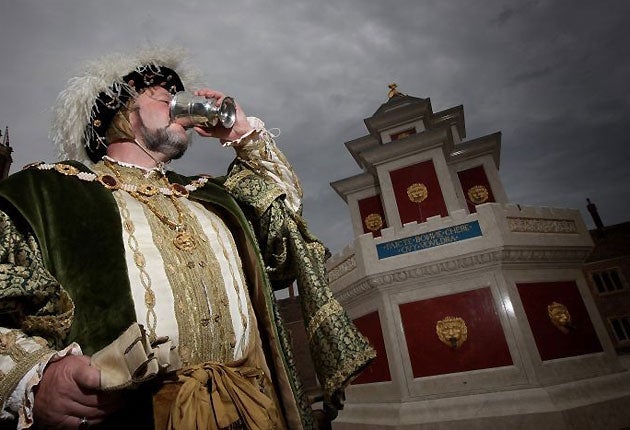Palace recreates wine fountain fit for a king

Your support helps us to tell the story
From reproductive rights to climate change to Big Tech, The Independent is on the ground when the story is developing. Whether it's investigating the financials of Elon Musk's pro-Trump PAC or producing our latest documentary, 'The A Word', which shines a light on the American women fighting for reproductive rights, we know how important it is to parse out the facts from the messaging.
At such a critical moment in US history, we need reporters on the ground. Your donation allows us to keep sending journalists to speak to both sides of the story.
The Independent is trusted by Americans across the entire political spectrum. And unlike many other quality news outlets, we choose not to lock Americans out of our reporting and analysis with paywalls. We believe quality journalism should be available to everyone, paid for by those who can afford it.
Your support makes all the difference.An English royal palace is to have wine on tap for the first time since the Tudors. Using a 16th-century painting of Henry VIII’s temporary palace at the Anglo/French political summit as a source, historians from Historic Royal Palaces have reconstructed a Tudor wine fountain at Hampton Court. It will dispense red and white wine and, eventually, rosé as well.
For a small fee, payable in modern currency rather than silver pennies, the public will be able to drink from it.
In Tudor times, wine fountains dispensed their contents free as an act of royal or civic largesse, but Historic Royal Palaces insists: “That wouldn’t be responsible. After all many of our visitors drive here.”
Hampton Court must also hope that other aspects of traditional Tudor drinking aren’t repeated. The painting which features the original wine fountain, the so-called Field of the Cloth of Gold, shows two men fighting in front of the fountain, a drunk being sick against the palace wall, sexual impropriety in full swing and a presumably inebriated man being led away by his lady friend. The painting is on show at Hampton Court.
The “fountain” is being installed in the main courtyard, the so called Base Court, and it is conceivable that a similar alcoholic facility stood there on special occasions in Henry VIII’s time. Last year, archaeologists excavating in Base Court discovered the foundations of what was probably a drinking fountain. But whether the installation was purely for water or occasionally for wine as well is unknown.
The excavation team, led by archaeologist Ben Ford of Oxford Archaeology, revealed that the original Base Court fountain was an octagonal structure, very similar in ground plan to the wine fountain in the Field of the Cloth of Gold painting, although substantially smaller.
At Ann Boleyn’s coronation, wine fountains were set up in Gracechurch Street, Cheapside and Fleet Street, and similar facilities were installed at Queen Elizabeth I’s coronation. In Oxford and Cambridge, the university colleges set up wine fountains when entertaining royalty.
The newly installed Tudor-style wine facility at Hampton Court is 4.3 metres high and can hold up to 320 litres.
“We’ve used original Tudor images of wine fountains and Hampton Court’s wealth of surviving architectural detail to recreate something truly unique,” said the Historic Royal Palaces historian in charge of the project, Dr Kent Rawlinson, curator of Historic Buildings at Hampton Court.
The wine is being imported from the same area King Henry got most of his wine: Gascony. Certainly Henry’s court had a taste for the stuff. The monarch had up to 15,000 gallons of wine in his cellar at Hampton Court at any one time. It must have been a substantial item in the royal accounts because in Tudor times, ordinary wine was, in relative terms, around three and a half times more expensive than it is now.
It was also delivered to the consumer in a very different way. It arrived by the barrel, not by the bottle. There were reds, whites and rosé – but, apart from that, no recognised variation in taste.
So it was up to the butler, down in the cellar, to add extra components as appropriate.
On hot summer days, spring water might be added to red wine to make it lighter. While on cold winter nights the butler might mix in quantities of sugar, ginger, cinnamon and nutmeg.
On the whole, however, wine fountains were summer phenomena – and delivered plain red wine, sometimes diluted with water. In Tudor times children would have drunk along with adults – but modern Hampton Court will be keeping strictly to the rules.
Join our commenting forum
Join thought-provoking conversations, follow other Independent readers and see their replies
Comments